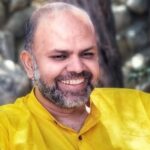Madam Blavatsky says in the Secret Doctrine, “…All this is very puzzling, to one who is unable to read and understand the Purana-s, except in their dead letter sense. Yet this sense, if once mastered, will turn out to be the secure casket which holds the keys to the secret wisdom. True, a casket so profusely ornamented that its fancy work hides and conceals entirely any spring for opening it, and thus makes the unintuitional believe it has not and cannot have any opening at all. Still the keys are there, deeply buried, yet ever present to him who searches for them”.
How does one discover this key that opens up the secure casket? The mere retelling of the stories and the aesthetic appreciation of its portrayal through dance and art is not enough. Recently a group of 32 people undertook a search to find the key, a search within, because surely the key is not lying on the ground somewhere!
We set out to explore the meaning of the word puraNa: pura api navam meaning ancient yet nascent. How does an ancient story become nascent? It does when it lives in the moment through us. So we set out to share our exploration of the ways in which each of the heroes of the mahabhArata lives in us, and through us; how these archetypes arise in various contexts and relationships. We became the subjects and the objects of our enquiry, we agreed to disclose the turmoil and struggle of our lives, the dilemmas we face that are reflected in the many stories of the mahabharAta. We dug deep into ourselves and watched the drama unfold as the daivic and asuric forces within us played out their eternal mantan; six days of intense self-enquiry, self-disclosure and sharing threw up a lot of insights. It was a watershed event for me to facilitate the group and watch the space unfold with vibrancy and meaning. We used therukkoothu, inner work, drawing, dialogue, sharing, and enactment to dive deep into our psyche.
It must be emphasized that a laboratory learning space is one where there is very little discourse or interpretation. The participants explore their own self, in their own context based on the triggers provided by the group exploration into the mahabhArata. The facilitator enable a deep and intense exploration where catharsis and ‘acting out’ of long held parts of the self become safe and in fact become the most important starting points of introspection.
Through exploring the metaphor of the mantan we discovered that the willingness to watch the flow of energy between the dark and light sides of our psyche is an essential pre-requisite. The moment we judge the dark as bad, we bring in our socialized and conditioned thought into the process and the mantan stops. The “good” is elevated; the “bad” is demonized and repressed. The possibility of looking at the two as forms of energy, of befriending one’s own violence and thus understanding its structure and nature, is lost. The possibility of looking at our hurts and staying with them so that they do not trigger processes of defensiveness and aggression is lost. The possibility of ending the poison that is generated within our psyche, and discovering aishwarya is lost. Is that why there was the mahabhArata war?
We explored many turning points in the saga of the pAndava and the kaurava. At each such turning point, the archetypal human energies are clearly etched out, the outer dilemma and the inner cacophony can be explored, one’s own inability to end the ancient war with the “other” and find a space for the emerging vulnerable and fresh life can be confronted.
We explored the archetype of draupadi through a dialogue with Jyotsana Narayanan (an accomplished dancer and dance teacher from Kalakshetra). She shared with us her exploration of pAnchAli (as she likes to call draupadi). Through the day we had explored the various personas that make up our psyche, namely the actor who is like a vessel endowed with many capabilities, the victim who holds hurt and pain, the guardian who is vigilant and ready to fight the world, the judge who evaluates us based on societal rules, the beckoner who searches for escapes, the friend who holds affection and honest appreciation, the dreamer who is the receptacle of our destiny, and the meditator who remains in silent and profound awareness of every nuance of our inner space. Jyotsana talked about the immense shakti of pAnchAli as she faces the court and asks each one of her husbands why they are frozen, confronts bheeshma with his paralysis, and challenges the kauravas from a core of integrity. When every effort to awaken the noble and the compassionate yield no outcome, pAnchAli awakens to her divine potential. pAnchAli becomes pure aspiration for the Thou; she lets go of all effort sourced in the self, accepts her vulnerability, and discovers krishNa, the Thou within.
Every one of us was stirred and touched by the dialogue. The idea that pAnchAli was a victim gave way to the realization that it was the vulnerable and the pure spark of atman, born of the sacred fire, a gift from the divine, the purest dream for oneself. When one awakens to this vulnerable self, the mantan begins.
Perhaps in this insight into the possibility of pAnchAli lies a window for each of us. Could we end our love affair with our victimhood and the vengefulness that it unleashes and open ourselves to embracing our vulnerability? In that baby step there lies an immense possibility for all of us.

 Anoop is a student of Yoga, an entrepreneur, a coach and a father of two young boys. He has led successful leadership stints in both the corporate and non-for-profit sectors. On encountering the country’s water/farmer crises at close quarters, he decided to pause and examine the impact various ‘isms’ – capitalism, colonialism, etc., were having on us as individuals, families, the society and the environment at large. This quest led him to formally engage with traditional Indic knowledge systems while also learning from the latest advances in science – about our physical and mental wellbeing, importance of body and mind work in healing trauma and the urgent need for a conscious rebuilding of family / work / social structures if we have to thrive individually and collectively. Insights, frameworks and processes gleaned from these on-going studies, an anchorage in his own personal practice and his wide-ranging experiences is what Anoop brings to facilitation/coaching spaces in Ritambhara and his various professional engagements.
Anoop is a student of Yoga, an entrepreneur, a coach and a father of two young boys. He has led successful leadership stints in both the corporate and non-for-profit sectors. On encountering the country’s water/farmer crises at close quarters, he decided to pause and examine the impact various ‘isms’ – capitalism, colonialism, etc., were having on us as individuals, families, the society and the environment at large. This quest led him to formally engage with traditional Indic knowledge systems while also learning from the latest advances in science – about our physical and mental wellbeing, importance of body and mind work in healing trauma and the urgent need for a conscious rebuilding of family / work / social structures if we have to thrive individually and collectively. Insights, frameworks and processes gleaned from these on-going studies, an anchorage in his own personal practice and his wide-ranging experiences is what Anoop brings to facilitation/coaching spaces in Ritambhara and his various professional engagements.
 Priya is a Yoga therapist in the Krishnamacharya tradition. She adapts Reiki & energy work, Vedic chanting, life coaching & Ayurvedic practices in her healing spaces. She is committed to nurturing collectives that have the praxis of Yoga at their heart.
Priya is a Yoga therapist in the Krishnamacharya tradition. She adapts Reiki & energy work, Vedic chanting, life coaching & Ayurvedic practices in her healing spaces. She is committed to nurturing collectives that have the praxis of Yoga at their heart. Anisha has been on an exploration to understand herself through yoga for the last 15years which led her to teaching yoga, yoga therapy and inner work through yoga.
Anisha has been on an exploration to understand herself through yoga for the last 15years which led her to teaching yoga, yoga therapy and inner work through yoga. Apoorva chanced upon Yoga in her early 20s. A spark was lit within and there was no turning back. Her exploration led her to the Krishnamacharya tradition more than a decade ago. Curious about human behaviour and what drives it, she was thrilled when her search ended (and also began) when she first came upon the Yoga Sutra, which illuminated a path towards answering many questions that had been held for a long time.
Apoorva chanced upon Yoga in her early 20s. A spark was lit within and there was no turning back. Her exploration led her to the Krishnamacharya tradition more than a decade ago. Curious about human behaviour and what drives it, she was thrilled when her search ended (and also began) when she first came upon the Yoga Sutra, which illuminated a path towards answering many questions that had been held for a long time. Anita is a yoga teacher and therapist in the tradition of Sri.T.Krishnamacarya and Sri T.K.V. Desikachar, a Reiki practitioner and a Life Coach. She is also the founder of Vishoka, a center for learning Indic and energy-based frameworks for living and healing. Her deep concern for human suffering and the problems of unsustainable living kept her on the path of seeking an integrated approach to looking at life, living, learning and healing.
Anita is a yoga teacher and therapist in the tradition of Sri.T.Krishnamacarya and Sri T.K.V. Desikachar, a Reiki practitioner and a Life Coach. She is also the founder of Vishoka, a center for learning Indic and energy-based frameworks for living and healing. Her deep concern for human suffering and the problems of unsustainable living kept her on the path of seeking an integrated approach to looking at life, living, learning and healing. Ankit is a seeker in the wisdom traditions of India. The core of his work includes creating dialogic spaces where people can look within and see the connection between their inner and outer lives. Inspired by the likes of Gandhi, Aurobindo, Vivekananda and Guru Gobind his experiments in service took him back to his roots in Punjab where he is creating a community-led model of higher education which is open, inclusive and accessible for all. Ritambhara for him is a space for engaging in a community which is committed to a DHramic life. He anchors his work of learning and leadership in the Antaranga Yoga Sadhana and the humanistic wisdom of Mahabharata.
Ankit is a seeker in the wisdom traditions of India. The core of his work includes creating dialogic spaces where people can look within and see the connection between their inner and outer lives. Inspired by the likes of Gandhi, Aurobindo, Vivekananda and Guru Gobind his experiments in service took him back to his roots in Punjab where he is creating a community-led model of higher education which is open, inclusive and accessible for all. Ritambhara for him is a space for engaging in a community which is committed to a DHramic life. He anchors his work of learning and leadership in the Antaranga Yoga Sadhana and the humanistic wisdom of Mahabharata.